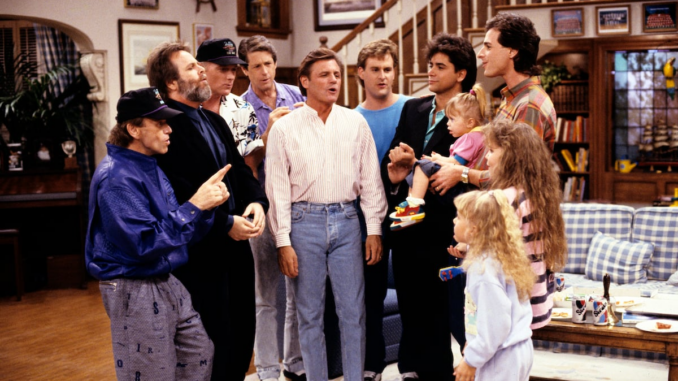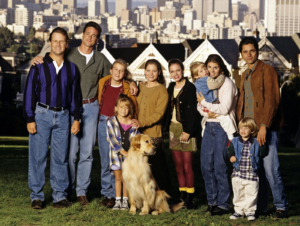
There are some shows that become more than just TV programs; they become a part of popular culture. Full House (1987) is one of those shows. Though it originally aired in the late ’80s and early ’90s, its impact has remained as fresh as ever. With its heartwarming moments, memorable characters, and family-friendly humor, Full House has transcended its era, becoming a beloved sitcom that appeals to people of all ages, even decades after its debut.
In this article, we’ll explore what made Full House (1987) so special and how it continues to resonate with viewers around the world.
The Story Behind Full House: A Family Like No Other
Full House centers around Danny Tanner, a widowed father, and his three young daughters—Donna Jo (D.J.), Stephanie, and Michelle. After the untimely death of his wife, Danny finds himself struggling to manage both work and home life. Fortunately, he’s not alone. His brother-in-law, Jesse Katsopolis, and his best friend, Joey Gladstone, step in to help raise the kids, forming a unique and loving blended family. Together, this eclectic group of characters navigates the ups and downs of daily life, from school drama to sibling rivalry and everything in between.
The central theme of Full House is family—no matter how unconventional. The show taught audiences that family isn’t always about traditional bloodlines; it’s about love, support, and togetherness.
The Stars That Made Full House Shine
What truly made Full House a standout show were the characters. Each character brought something unique to the table, and their chemistry together was magnetic. The cast became a tight-knit family, both on and off-screen, and that connection translated into the heartwarming and funny moments we all love.
Bob Saget as Danny Tanner:
Bob Saget’s portrayal of Danny Tanner is one of the most iconic TV dads of all time. His portrayal was a perfect blend of the kind, nurturing father who was often exasperated but always trying his best. With his famous “Clean up this room!” and obsession with cleanliness, Danny’s character became the father figure that many viewers admired.
John Stamos as Uncle Jesse Katsopolis:
Uncle Jesse was the rockstar-turned-family-man who brought a cool, carefree attitude to the show. Played by John Stamos, Uncle Jesse was the perfect balance of humor, charm, and emotional depth. His transition from a self-centered bachelor to a responsible father figure for his nieces and nephews was one of the show’s most heartwarming storylines.
Dave Coulier as Joey Gladstone:
Dave Coulier’s portrayal of Joey, the goofy yet lovable comedian, provided much-needed comic relief. His impressions, slapstick humor, and dedication to making the kids laugh made him the quirky, fun-loving uncle everyone wanted in their lives.
Mary-Kate and Ashley Olsen as Michelle Tanner:
Perhaps the most iconic of all, the Olsen twins played Michelle Tanner, the youngest of the Tanner children. Michelle’s witty catchphrases and adorable antics helped define the show’s lighthearted tone. The twins’ chemistry and natural charm made Michelle one of the most memorable characters in TV history.

Why Full House (1987) Was a Cultural Game Changer
Full House was more than just a sitcom; it was a trailblazer in the world of family television. The show not only entertained audiences but also addressed real-world issues with humor and heart.
1. The Emphasis on Family Values
One of the biggest reasons Full House stood out was its focus on family values. It wasn’t just about the laughs—it was about the relationships between family members and how they supported each other through thick and thin. The show emphasized respect, kindness, and togetherness, making it relatable to families from all walks of life.
2. The Show Balanced Humor with Life Lessons
While many sitcoms of the time relied solely on humor, Full House introduced an emotional depth that wasn’t often seen in comedy shows. The characters didn’t just tell jokes—they also learned important life lessons. Whether it was about forgiveness, empathy, or the importance of communication, Full House always found a way to teach viewers valuable lessons, without ever losing its comedic touch.
3. Strong Female Characters
The show also broke barriers by giving young girls prominent roles. D.J., Stephanie, and Michelle were the heart of the show. D.J., the oldest Tanner child, was a role model for young girls, showing them that it’s okay to be strong, smart, and compassionate. Stephanie, the middle child, often played the voice of reason, and Michelle, though young, was full of spunk and sass.
Full House’s Global Success
While Full House was initially a hit in the United States, it quickly gained a global following. The universal themes of love, family, and friendship resonated with audiences from all over the world, and the show was soon broadcast in over 50 countries.
The show’s international appeal can be attributed to its simplicity and universal messages. Whether in the UK, Latin America, or Asia, viewers could relate to the family struggles and triumphs that the Tanner family faced. It wasn’t just an American show—it was a worldwide phenomenon.
The Impact of Full House on Future TV Shows
The influence of Full House cannot be overstated. The show set the blueprint for countless family sitcoms that followed. Its combination of humor, heart, and family dynamics became the standard for family-oriented TV programming.
Shows like The Middle, Modern Family, and The Goldbergs owe much of their success to Full House‘s approach to storytelling and character development. In many ways, Full House revolutionized the family sitcom genre, demonstrating that family-focused TV shows could appeal to both children and adults.
Full House’s Legacy: Why We Still Love It
Even though Full House ended in 1995, its legacy has never faded. The show’s impact can be seen in the numerous reunions, spin-offs, and references to Full House in modern pop culture. In 2016, the Netflix series Fuller House revived the Tanner family for a new generation, proving that the magic of Full House was far from over.
Fans continue to watch reruns, quoting their favorite lines and reliving the iconic moments that made the show so special. The show’s timeless themes of family, love, and support continue to resonate with audiences, making it a show that will be remembered for years to come.
Conclusion: Full House (1987) – A Show That Endures Across Generations
Full House (1987) is more than just a sitcom—it’s a family legacy that continues to bring people together. Its heartwarming storylines, memorable characters, and timeless humor made it a beloved show during its original run and continue to make it relevant today. From its unforgettable catchphrases to its lessons on love and friendship, Full House holds a special place in the hearts of millions of fans worldwide. It’s a show that will never truly go out of style, and its influence on TV history is undeniable.
FAQs
- How many seasons did Full House have?
- Full House aired for eight seasons, from 1987 to 1995, with a total of 192 episodes.
- What was the message behind Full House?
- The show focused on the importance of family, love, and the value of sticking together through tough times.
- Who was the most popular character on Full House?
- While all the characters were beloved, Uncle Jesse (John Stamos) and Michelle Tanner (Mary-Kate and Ashley Olsen) were particularly popular due to their unique charm.
- Did Full House have a reunion?
- Yes, in 2016, the cast returned in Fuller House, a Netflix revival that brought back many of the original characters and introduced new ones.
-
Why did Full House remain popular after all these years?
- Its universal themes of family, humor, and love, combined with its relatable characters, have kept Full House relevant and adored by fans worldwide.
